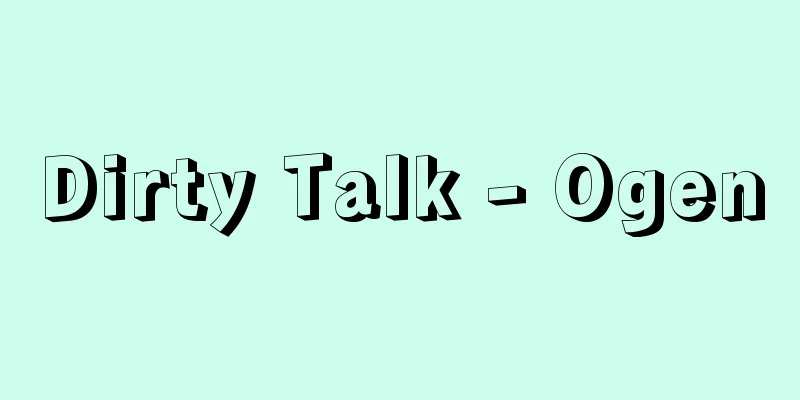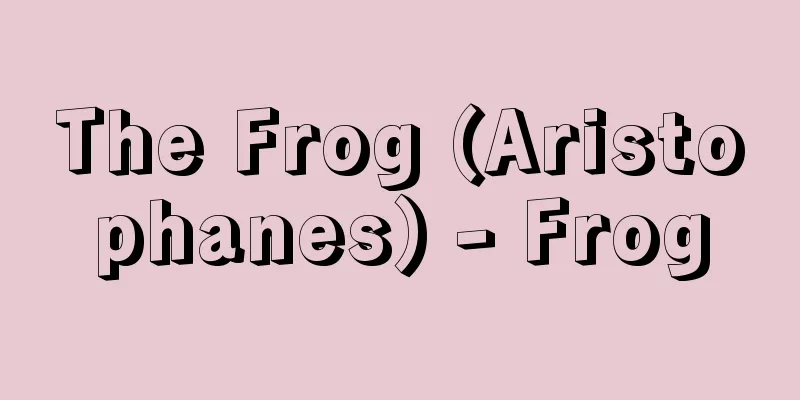Cooperative phenomenon

|
This is also called a cooperative phenomenon. The interaction between the individual atoms or molecules that make up a substance cooperates, resulting in the appearance of new properties that differ from the properties of the individual particles. A typical example of a cooperative phenomenon is the phase transition phenomenon, but as examples of collective motion, lattice vibrations, plasma vibrations, and spin waves in ferromagnetic materials will be explained. [Fukuro Ono] Lattice vibration In a crystalline solid, atoms or ions are arranged in a regular pattern. There is an interaction between nearby atoms, and they maintain a balanced distance from each other. If they get any closer than this, a repulsive force will be exerted, and if they move farther apart, an attractive force will be exerted, trying to return them to the balanced position. If one of these atoms is suddenly moved by an external force, and it moves slightly out of the balanced position, it will push the surrounding atoms. The movement of the surrounding atoms is then transmitted to the next atom. Meanwhile, the original atom receives a force (restoring force) from the surrounding atoms that tries to return it to its original position. This causes vibrations, which are then transmitted to the surrounding atoms one after another. This is called lattice vibration, or sound waves in a solid. Unlike the random thermal movement of atoms, this type of wave motion is the result of the cooperative movement of many atoms. If the propagation speed of the wave motion is c , when the wavelength λ (lambda) is longer than the lattice spacing, the frequency ν (nu) is ν = c / λ [Fukuro Ono] Plasma Oscillations When an electric field is applied to plasma, which is a mixture of positive ions and negative electrons resulting from ionization of atoms, the positive ions and negative electrons move in opposite directions, resulting in polarization as a whole. The electric field generated by this polarization is proportional to the magnitude of the polarization and acts in the direction of reducing the polarization, which acts as a restoring force and allows the polarization to oscillate. This oscillation is called plasma oscillation and propagates as a longitudinal wave. Its natural frequency is [Fukuro Ono] Spin WavesThere are spin waves as the cooperative motion of quantum spins. In a ferromagnetic material (magnet), the ions that make up the lattice have their own angular momentum. This angular momentum is called the spin of the ion, and it has a magnetic moment. A quantum mechanical exchange interaction is at work between the spins of adjacent ions, and if the sign is positive, it is a force that aligns the spins in parallel. At low temperatures, the disturbance due to thermal motion is small, and the magnetic moments are almost aligned in parallel, resulting in ferromagnetism. If a spin is tilted from parallel, a force is exerted that tilts the surrounding spins slightly. This tilt causes the spins to precess, and the phenomenon in which this is transmitted one after another as a wave is called a spin wave. In sound waves inside a solid, the displacement of atoms is propagated as a wave, but here, the precession of the spins is transmitted as a wave. [Fukuro Ono] Magnetic phase transitionThis article describes the cooperative phenomenon that occurs during the phase transition between the paramagnetic and ferromagnetic phases. The ferromagnetic phase is what we call a permanent magnet, and has spontaneous magnetization. In addition to metals such as iron and nickel, oxides of transition metals, such as ferrite, can also be magnetized. The metal ions that compose these substances have magnetic moments. At high temperatures, due to thermal motion, the orientation of each magnetic moment is random, and the substance as a whole is in a paramagnetic phase with no magnetization. An external magnetic field is required to achieve magnetization. In materials that can be used as permanent magnets, there is a force called exchange interaction between the spins of adjacent ions that tries to make the magnetic moments parallel, so when the temperature drops and the thermal motion weakens, the magnetic moments become parallel from the closest points. When the temperature drops further, a correlation occurs in which even the spins that are far away become parallel, and magnetization occurs as a whole. This transition temperature is called the Curie temperature. At high temperatures, when the orientation of the surrounding magnetic moments is random, the direction of the force is also random, and the force acting on the central magnetic moment is canceled out and disappears. When the temperature drops, the random thermal motion of the magnetic moments decreases, increasing the parallel component of the magnetic moments, and a synergistic effect occurs in which the force that makes them parallel to each other is further increased. Therefore, below the Curie temperature, magnetization due to a decrease in temperature increases rapidly and nonlinearly. This is a cooperative phenomenon. [Fukuro Ono] [Reference] |Source: Shogakukan Encyclopedia Nipponica About Encyclopedia Nipponica Information | Legend |
|
協力現象ともいう。物質を構成する個々の原子や分子間の相互作用が協力的に働くことにより、個々の粒子の性質とは異なった新しい性質が現れる現象。協力現象として典型的なのが相転移現象であるが、集団運動の例として、格子振動、プラズマ振動、強磁性体のスピン波について解説する。 [小野昱郎] 格子振動結晶となった固体では、原子またはイオンが規則正しく配列している。近傍の原子間には相互作用が働いており、互いにつり合いの距離を保っている。これ以上近づくと互いに斥力(せきりょく)が、離れると引力が働き、つり合いの位置に戻そうとする。その中の一つの原子が外力で急に動かされ、つり合いの位置からすこし外れると、周囲の原子を押し動かす。さらに周囲の原子の運動が次の原子に伝えられる。一方、元の原子は周囲の原子から元に戻るような力(復元力)を受ける。そのため振動がおこり、その振動が次々と周囲へ伝わっていく。これを、格子振動、または固体内の音波とよぶ。このような波動は原子のランダムな熱運動と異なり、多数の原子の協同運動の結果である。波動の伝播(でんぱ)速度をcとすれば、波長λ(ラムダ)が格子間隔に比べ長いときは、その振動数ν(ニュー)は [小野昱郎] プラズマ振動原子が電離した正イオンと負の電子が混合したプラズマに、電場をかけると、正イオンと負電子は逆方向に動き、全体として分極が生じる。この分極によって生じた電場は、分極の大きさに比例し、分極を減らす方向に作用しているので、これが復元力となり、分極は振動することができる。この振動をプラズマ振動といい、縦波として伝播する。その固有振動数は [小野昱郎] スピン波量子スピンの協同運動としてのスピン波がある。強磁性体(磁石)では、格子を構成しているイオンが固有の角運動量をもつ。この角運動量をイオンのスピンといい、磁気モーメントをもっている。隣接したイオンのスピンの間には、量子力学的な交換相互作用が働いており、符号が正であれば、スピンを平行にそろえる力になっている。低温では熱運動による乱れが小さく、磁気モーメントはほぼ平行にそろっているので、強磁性が実現している。もし、どこかのスピンが平行から傾くと、その周りのスピンをすこし傾ける力が働く。この傾きがスピンの歳差運動を引き起こし、それが次々と波動として伝わる現象がスピン波である。固体内の音波は原子の変位が波動として伝播するが、ここでは、スピンの歳差運動が波動として伝わることになる。 [小野昱郎] 磁気相転移常磁性相と強磁性相の相転移における協同現象について述べる。強磁性相はいわゆる永久磁石のことであり、自発磁化をもつ。鉄やニッケルなどの金属のほかに、フェライトに代表される遷移金属の酸化物も磁石になる。これらの物質はそれを構成している金属イオンが磁気モーメントをもっている。高温では、熱運動のため各磁気モーメントの向きは、ランダムな方向を向き、全体としては磁化をもたない常磁性相になっている。磁化をもつには外部磁場が必要である。 永久磁石となる物質では近接したイオンのスピン間には交換相互作用という磁気モーメントを平行にさせようとする力が働いているので、温度が下がって熱運動が弱くなってくると、磁気モーメントは近いところから平行になっていく。さらに温度が下がると、遠いところのスピンまで平行となる相関が生じ、全体としての磁化が生じる。この転移温度をキュリー温度といっている。高温で周りの磁気モーメントの向きがランダムのときはその力の向きもランダムであり、中心の磁気モーメントに働く力は打ち消されて消えてしまう。温度が低下すると、磁気モーメントのランダムな熱運動が減少することによって、磁気モーメントの平行の成分が増えていき、さらに互いに平行にさせる力を増すという相乗効果が働いている。したがって、キュリー温度以下で温度の低下による磁化は急激で、非線形に増加する。これが協同現象である。 [小野昱郎] [参照項目] |出典 小学館 日本大百科全書(ニッポニカ)日本大百科全書(ニッポニカ)について 情報 | 凡例 |
<<: Utility tunnel - Kyodoukou
>>: Co-determination law - Kyodo ketaiho
Recommend
NATM - New Attack on Titan
...Steel arch supports have the advantage of bein...
Mama River - Mama River
Title of a jiuta/koto song. Kyoto-style tegotomono...
Cayenne (Plant) (English spelling) Cayenne
…var. longum (English name: long pepper) produces...
Sāṭi' al‐Ḥusrī
1880‐1968 An Arab nationalist who was active as an...
Strictly monotonically increasing
...Increasing and decreasing functions are collec...
Error
...Tomi Ungerer (1931- ), from France, creates pi...
Japan Atomic Power Company
Founded in 1957 with investments from nine electri...
Out-group
…Of course, the ideality of the task and the timi...
Sadayo Imagawa
Year of death: Unknown (Year of death unknown) Yea...
Lehmbruck, W.
…After the emergence of Reinhold Begas (1831-1911...
Sequoia National Park - Sequoia National Park (English name)
A national park in central-eastern California, Un...
Edo Tayu Kawato - Edo Tayu Kawato
⇒ Masumi Kato (first generation) Source: Kodansha ...
Control system
A systematic collection of control devices introdu...
Industrial hygiene
In modern society, workers take up a job and parti...
Denier (English spelling)
A unit of measurement for the thickness (fineness)...





![Long-Term Credit Bank of Japan [Stock] - NIHON CHOKISHINYOGINKO](/upload/images/67cc711db17ee.webp)



